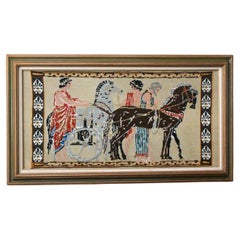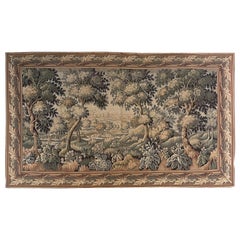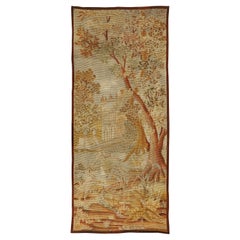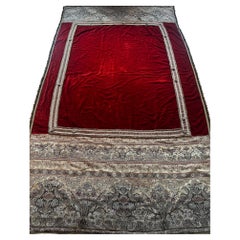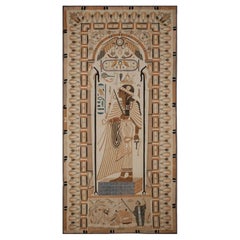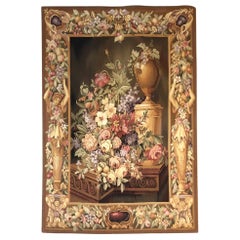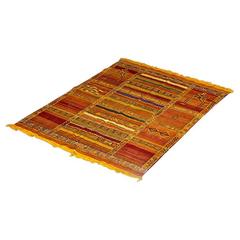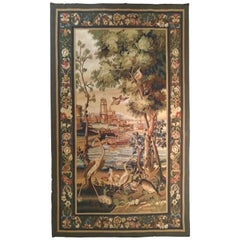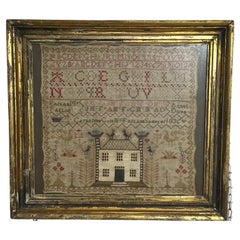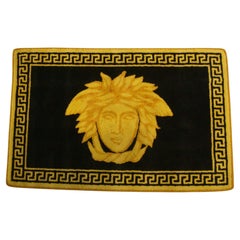Revival Tapestries
9
3
1
to
3
9
3
13
12
12
511
313
106
91
80
72
46
28
22
19
16
15
14
10
8
5
5
3
5
4
4
2
2
Height
to
Width
to
13
6
5
1
1
7
4
3
3
3
3
Style: Revival
COLOSSAL! MCM Greek Revival Tapestry! 1950s Frederic Weinberg Era Wall Art Decor
Located in Peoria, AZ
MONUMENTAL!
GREEK REVIVAL
MID CENTURY
TAPESTRY!
DIMENSIONS: VERY LARGE 57" x 32"
ICONIC MID CENTURY GREEK REVIVAL ART!
Greek revival was a important part of upscale fifties decor! This is a wonderful tapestry of a chariot, rider and handlers that perfectly captures this Greek revival style!
Frederic Weinberg is one artist who created mid century Etruscan...
Category
Mid-20th Century American Revival Tapestries
Materials
Fabric
Grand Antique French Tapestry by Gobelins of Paris
Located in Dallas, TX
Grand Antique French Tapestry by Gobelins of Paris is a stunning panoramic landscape scene depicting a lush wooded area on the outskirts of a rural village. Crafted on a large scale, it spans almost seven and a half feet tall by almost thirteen feet wide! Styled after the storied Oudenaarde tapestries...
Category
Early 20th Century French Revival Tapestries
Materials
Wool
Tapestry Portiere Country House Terrace Birds
Located in BUNGAY, SUFFOLK
-Attractive tapestry unusually depicting a large Baroque country house or mansion with turrets in the background
-The four exotic birds in the foregro...
Category
19th Century English Antique Revival Tapestries
Materials
Wool
Large Antique Italian Silk Velvet Wall Hanging
Located in Doha, QA
This is a truly exquisite antique silk velvet wall hanging with hand woven floral peacock design and metal threads as a patchwork. The history of V...
Category
Early 19th Century Italian Antique Revival Tapestries
Materials
Metallic Thread
1890's Antique Egyptian Cotton Applique Tapestry
Located in Plainview, NY
A late 19th century Circa 1890's antique Egyptian cotton applique tapestry featuring intricate designs and in a brown and beige tone color. The tapes...
Category
19th Century Egyptian Antique Revival Tapestries
Materials
Cotton
Vintage Aubusson-Style Tapestry
Located in Dallas, TX
Vintage Aubusson-style tapestry is a celebration of the bounty of the earth, with amazing fruit and floral designs incorporated into the border which surrounds the splendid still lif...
Category
Mid-20th Century French Revival Tapestries
Materials
Wool
Antique Renaissance Styled Hand-Embroidered Sampler Panel or Tapestry Fragment
Located in Hamilton, Ontario
This antique framed hand-embroidered textile is unsigned, and presumed to have originated from Italy and dating to approximately 1900 and done in a Renaissance Revival style. This pi...
Category
Early 20th Century Italian Revival Tapestries
Materials
Silk
Framed Antique French Cherub Tapestry
Located in New York, NY
French (19th-20th century) beige and brown tapestry depicting a scene of several cherubs on a forest hillside in a rectangular wooden frame.
Category
Late 19th Century French Antique Revival Tapestries
Materials
Tapestry
19th Century Italian Sucre de Herb Tapestry
Located in Dallas, TX
19th century Italian Sucre de Herb Tapestry features a shapely maiden dancing and playing a tambourine, while a leering Bacchus admires her in the backgr...
Category
1890s Italian Antique Revival Tapestries
Materials
Wool
Over-dyed Lemon Yellow Natural Silk Hand-Knotted Classic Pattern Rug in Stock
Located in New York, NY
The Rumi collection master weavers artfully re-spin and hand-knot the finest remnants of sustainable sari-silk to create the breakthrough Rumi Silk collection. These remarkable patte...
Category
2010s Indian Revival Tapestries
Materials
Silk
Ottoman Style Silk Embroidered Textile Hanging or Spread
Located in Milan, IT
A highly refined embroidery ornated by an infinite repeat of stylized palmettes and leafs typical of 16th century ottoman court workshops. It belongs to a group of weavings commissio...
Category
Early 2000s Turkish Revival Tapestries
Materials
Silk
Rust Orange Silver Silk Beige Rug Hand-Knotted Ikat Pattern with Luxe Weave
Located in New York, NY
The Rumi collection master weavers artfully re-spin and hand-knot the finest remnants of sustainable sari-silk to create the breakthrough Rumi Silk collection. These remarkable patte...
Category
2010s Indian Revival Tapestries
Materials
Silk
Silver and Grey Natural Silk Hand-Knotted Ikat Rug with Plum Red Accent in Stock
Located in New York, NY
The Rumi collection master weavers artfully re-spin and hand-knot the finest remnants of sustainable sari-silk to create the breakthrough Rumi Silk collection. These remarkable patte...
Category
2010s Indian Revival Tapestries
Materials
Silk
Related Items
Wall Hanging Made from the Silk of Wedding Bands
Located in London, GB
Moroccan wall hanging made from the silk of wedding bands.
Category
20th Century Moroccan Revival Tapestries
Materials
Fabric
958 - Tapestry Aubusson Harbor and Birds
Located in Paris, FR
Tapestry Aubusson Harbor and birds.
Category
1960s French Vintage Revival Tapestries
Materials
Wool
Antique French Painted Tapestry
Located in Alessandria, Piemonte
O/4795 - Unusual elegant painted tapestry, suitable on wall. To customize it, You can write your initials' name in the cartouches in the corners. I...
Category
Late 19th Century French Antique Revival Tapestries
Materials
Canvas
Tapestry Tribute to Joan Miró's 'Woman and Bird', circa 1960
By Joan Miró
Located in Barcelona, Barcelona
Tapestry Tribute to Joan Miró's 'Woman and Bird', circa 1960
Circa 1960
Handmade tapestry
Inspired by Joan Miró's sculpture "Woman and Bird"
Framed in black lacquered wood
Dimension...
Category
1960s Spanish Vintage Revival Tapestries
Materials
Wood
Tapestry Wall Hanging Decor Hunting Scene
Located in Barntrup, DE
This colorful vintage tapestry shows the European hunting scene in the 18th century.
It is 100% wool quilted and comes with 4 loops for easy hanging.
This wall-hanging tapestry is m...
Category
Late 20th Century Belgian Revival Tapestries
Materials
Wool
Tapestry Royal Manufacture of Aubusson, Louis XVI period 1738 at the Gobelins
Located in Madrid, ES
Tapestry from the Royal Manufacture of Aubusson, Louis XVI period , made in 1738 at the Gobelins
One panel from a series of Gobelins tapestries depicting the History of Esther, illustrating Esther seated and attended by handmaidens, one washing her feet in golden basin, another fastening a bracelet, another offering a mirror, all observed by Mordecai, woven in the workshop of Michele Audran after a design by J. F. de Troy.
The Toilet of Esther c.1778-85.Royal Collection Trust-Queens Audience Chamber
Windsor Castle
The Sketches for the Esther Cycle by Jean-François de Troy (1736)
“and the maid was fair and beautiful; whom Mor’decai, ..., took for his own daughter.” (Est. 2:7)
A supple and undulating genius, both a flattering portraitist and a prolix history painter, as well as a brilliant genre painter, in a gallant or worldly vein, Jean-François de Troy (Paris, 1679 – Rome, 1752), solicited, although he had passed the threshold of old age, a new royal commission up to his ambitions. To obtain it, he submitted – successfully - for the approval of the Bâtiments du roi (administration), seven modelli painted in 1736 with his usual alacrity.
Inspired by one of the most novelistic texts of the Old Testament, the Book of Esther, these sketches in a rapid and virtuoso manner were transformed by the artist, between 1737 and 1740 into large cartoons intended to serve as models for the weavers of the Gobelins factory. Showing undeniable ease and skill in the composition in perfect harmony with the sensitivities of the times, the tapestry set met with great success.
The Story of Esther perfectly corresponded to the plan of the Bâtiments du roi to renew the repertoire of tapestry models used for the weavers of the royal factories while it also conformed to the tastes of Louis XV’s subjects for a fantastical Orient, the set for a dramatic tale in which splendour, love and death were combined. Indeed, no tapestry set was woven in France during the 18th century as often as that of Esther.
The series of modelli painted by de Troy during the year 1736 looks to the history of French painting and decoration under Louis XV as much as it does the history of the Gobelins. It probably counts among the most important rococo pictorial groups to have remained in private hands. First the Biblical source illustrated by De Troy which constitutes the base of one of the richest iconographical traditions of Western art will be considered. Then the circumstances and specific character of French civilisation during the reigns of Louis XIV and Louis XV which contributed to making the theme of Esther a relevant subject, both attractive to contemporaries and remarkably in line with the sensitivities of the time will be elucidated.
An examination of the exceptional series of sketches united here, the cartoons and the tapestries that they anticipate as well as a study of their reception will close this essay. The Book of Esther: A scriptural source at the source of rich iconography.
The origin of the Esther tapestry set by Jean-François de Troy – origin and creation of a masterpiece
According to the evidence of one of the artist’s early biographers, the chevalier de Valory, author of a posthumous elegy of the master, read at the Académie royale de peinture et de sculpture on 6 February 1762, it was apparently due to early16 rivalry with François Lemoyne (1688-1737), his younger colleague who had precisely just been appointed First Painter to the King in 1736, that had encouraged François de Troy to seek a commission allowing him to show off his ease and his promptitude at the expense of a rival who was notoriously laborious: “M. De Troy, retaining some resentment of the kind of disadvantage which he believed to have suffered compared with his emulator looked to regain some territory by making use of the facility his rival did not possess.
Lemoyne was excessively long in the creation of his works,and M. De Troy of a rare celerity: consequently, with this particular talent, the latter offered to the court to make paintings appropriate to be executed at the Gobelins Factory; and it is to this circumstance that we owe the beautiful series of the Story of Esther, which would be sufficient alone to give him a great reputation.”17 Beyond the suspicion inspired by the topos, which still constitutes, more or less, a tale of rivalries between artists in ancient literature, there is probably some truth in what Valory reports although A.-J. Dezalier d’Argenville (who indicates rather spitefully that de Troy did not hesitate to “cut prices” to impose himself, benefitting from the productivity assured by the unlikely rapidity of his brush)18 proves to be more evasive: “As he looked to busy himself, he had offered to make the paintings that serve as models for the King’s tapestries cheaply: which did not please his colleagues.
He was given a choice of two tapestry series to be made and he took the Story of Esther and that of Jason”.19 Whether or not the choice was actually left to de Troy (which would appear rather casual on the royal administration’s part all the same), it seems likely that the artist, whose contemporaries extol his “fire”, as the faculty of invention was then called, must have ardently aspired to the possibility of using on a very large scale the “creative genius” with which Dezallier d’Argenville credits him. The decoration of the private apartments, the fashion for which Louis XV had promoted at Versailles and Fontainebleau, offered little opportunity to excel in this area. Other than painting for altarpieces, only tapestries could allow comparison with Lemoyne who had been granted – unfortunately for him – a major decoration: the enormous ceiling of the Hercules Room at Versailles. Favoured by the recent improvement in France’s financial situation, the revival of patronage offered de Troy a commission fitting for him, in a field in which, however, he had hardly any experience.
Anxious to renew the repertoire of models available to the Gobelins factory, the Duc d’Antin, surintendant des Bâtiments du roi from 1708 to 1736 followed by his successor, Philibert Orry comte de Vignory, gave him the task of producing seven large cartoons inspired by the Book of Esther corresponding to the brilliant sketches or modelli which de Troy had produced in one go, or almost (very few preparatory drawings can in fact be linked to the Esther cycle and all seem to be at the execution stage of the cartoons).20 Subjected to the approval of the Administration des Bâtiments according to the procedure in use for projects being planned for the Gobelins, sketches made rapidly during 1736 were approved and the project launched immediately. Thereupon came the news of François Lemoyne’s death, who, ground down by work and a victim of his private torment, committed suicide on 4 June 1737.
Against all expectations, de Troy did not replace his rival in the position of First Painter (which remained vacant until the appointment of Charles Coypel in January 1747), which would perhaps have made him too obviously the beneficiary of the drama. The awarding of the position of Director of the French Academy in Rome came to console him while he had already produced (or he was in the process of finishing), in Paris, three of the seven cartoons of the cycle (The Fainting of Esther finished in 1737 and the Toilet and Coronation of Esther, both finished in 1738).
De Troy, we can see, did not follow the order of the narrative but began with the subjects which apparently offered the least difficulty because he had already depicted them, or because they fall into a strong pictorial tradition (such is the case especially for the Fainting of Esther). He had hardly settled at the Palazzo Mancini in August 1738, when his first task which awaited the new director of the French Academy naturally consisted of honouring the royal commission and finishing without delay the final cartoons of the Story of Esther after the sketches he must have taken with him. As prompt as ever, de Troy discharged himself of the execution of the four remaining cartoons in only two years, by beginning with the largest format which allowed him to strike the imagination and to impose himself as soon as he arrived on the Roman stage: the Triumph of Mor’decai which was finished in 1739 (like Esther’s Banquet).
The following year, the Mor’decai's Disdain and The Sentencing of Haman were brought to an end in the same Neo-Venetian style, obviously tributary to Veronese with its choice of “open” monumental architecture which is characteristic of the entire cycle.21 The series, it should be noted, was almost augmented with some additional scenes in the mid 1740s. Indeed, the first tapestry set finished at the Gobelins in 1744 proved to be unsuitable for the arrangement of the Dauphine’s apartments at Versailles for which it had been intended to decorate the walls the following year (cf infra). Informed of this, de Troy, considering that the story of Esther offered “several good subjects,” immediately offered to illustrate one or new subject among those “which could appear to be the most interesting”.
The directeur des Bâtiments Orry, who managed the State’s accounts, obviously judged it less costly to have one of the tapestries widened to fill in the end of the Dauphine’s bedroom,22 which has probably deprived us of very original compositions, because de Troy had already illustrated the most famous themes, those that benefitted from a strongly established iconographical tradition and from which it was not easy to deviate
The Tapestry Set of the Story of Esther
Placed on the tapestry looms of the Gobelins at the end of the 1730s in Michel Audran’s workshop, the cycle created by de Troy aroused true infatuation. The few hundred tapestries made between 1738 and 1797 – all in high-warp tapestry and woven in wool and silk except for four in low-warp made in Neilson’s workshop – show the impressive success of a tapestry set that was without any doubt the most frequently woven of the 18th century in France.
29 Only three cartoons had been delivered by de Troy in 1738 when the first tapestry set was begun by Audran under the expert eye of Jean-Baptiste Oudry to whom the Directeur général des bâtiments, Philibert Orry had assigned the (weekly) supervision of the weaving. During the summer of 1738, the piece of the Fainting of Esther, which Oudry judged to be admirable, was finished.
During the winter of 1742, Oudry informed Orry that about two ells of the Triumph of Mor’decai had been made “with no faults”,that the Coronation of Esther was finished and that the Esther at her Toilet “a very gracious tapestry” was “a little over half” finished. Exhibited at Versailles in 1743, these two last pieces were admired by Louis XV and the Court.
On 3 December 1744, the set of seven tapestries was finally delivered to the Garde Meuble. It was intended, the honour was not slight, to decorate the apartments of the Infanta Maria Teresa Rafaela of Spain whose marriage to the young Dauphin Louis-Ferdinand had been fixed for the following year (it took place on 23 February 1745). Apparently it was thought that the theme of Esther the biblical heroine and wife of a foreign sovereign was appropriate for the apartments of the Spanish Dauphine.
As early as the month of March, the architect Ange-Jacques Gabriel informed de Troy that her grand cabinet was decorated with the “Esther tapestry set” specifying however that “for lack of two small or one large piece, we have not been able to decorate the end of the room”. This difficulty led immediately to the Banquet episode being woven a second time in two parts (they were delivered to the Garde-Meuble on 30 December 1746) to garnish the panels on each side of the bed of the Dauphine who would hardly enjoy them (she died on 22 July 1746 and the decoration was installed for the new Dauphine Maria Josepha of Saxony).
The appearance of the set’s remarkable border, which imitated a richly sculpted wooden frame, should be mentioned. Conceived in 1738 by the ornamentalist Pierre Josse-Perrot and used in the later weavings until 1768, it tended to reinforce the resolutely painterly appearance of the tapestry set which, in this regard, pushed the art of tapestry as far as its ultimate mimetic possibilities. With the exception of Mor’decai's Disdain which had been removed earlier, the “editio princeps” of the story of Esther (from then on in nine pieces) remained at Versailles until the Revolution. Of the eight surviving tapestries, four are at the chateau of Compiègne and four belong today to the Mobilier National. No less than seven tapestry sets reputed to be complete (one of them in fact only had six tapestries) would be produced officially at the Gobelins up to 1772.
Literature:
1- The Œuvres mêlées of an emulator of Racine, the Abbé Augustin NADAL thus include an Esther. Divertissement spiritual which is exactly contemporary with Jean François de Troy’s cycle since it was performed in 1735 and published in Paris three years later.
2-Le Siècle de Louis XIV, 1751, 1785 ed., p. 96-97 for French ed.
3- Lemoyne and de Troy had been obliged to share the First Prize in the competition organised in 1727 between the most prominent history painters of the Académie Royale.
4- Mémoires…, pub. L. DUSSIEUX et al., 1854, II, p.265.
5-The fact that de Troy, at the risk of falling out with his colleagues, did not hesitate to make use of prices in order to convince the new directeur des Bâtiments Philibert Orry, is confirmed by Mariette who adds tersely “it caused much shouting” (pub. 1851-1860, II, p. 103).
6- Abrégé de la vie des plus fameux peintres…, ed. 1762, IV, p. 368-369 20 Early comments on the painter are inclined to present him as a kind of “pure painter”, doing without the medium of drawing, a few intermediary studies between the Esther sketches and the large cartoons at the Louvre nevertheless show that de Troy used red chalk (see in the catalogue, the notice for the Meal of Esther and Ahasuerus under the entry drawing) to change one or other figure.
7-C. GASTINEL-COURAL (cat. exp. PARIS, 1985, p. 9-13) as well as the article by J. VITTET, exh. cat. LA ROCHE-GUYON, 2001, p. 51-55.
8-The Hermitage in St. Petersburg conserves five tapestries of these two royal gifts whose provenance still awaits elucidation (as far as we are aware). In 1766, the Grand Marshal of Russia, Count Razumovski (or Razamowski), acquired the Fainting and the Banquet extracted from the sixth weaving (J. VITTET, 2001, p. 53).
9- Lettres écrites de Suisse, d’Italie…,quoted by J. VITTET, op. cit., p. 54.
10-The tapestry set remained in the hands of a branch of the Hapsburg-Lorraine family until 1933 (ibid. P. 54).
11-Quoted by Chr. LERIBAULT, 2002, p. 97, note 269.
12-Y. CANTAREL-BESSON, 1992, p. 241.
Catalogue
The Esther at her Toilet
Oil on canvas, 57 x 51 cm Provenance: Painted in 1736 at the same time as the six other modelli of the Story of Esther intended to be presented, for approval, to the direction des Bâtiments du Roi; perhaps identifiable among a lot of sketches by Jean-François de Troy in the post mortem inventory of the amateur, historian and critic Claude-Henri Watelet (1718-1786) drawn up on 13 January 1786 and following days (A.N. T 978, n° 30) then in the sale of the property of the deceased, Paris, 12 June 1786, n° 33; Paris, François Marcille Collection (who owned a series of six sketches from which the Triumph of Mor’decai was missing, see infra); Paris, Marcille Sale, Hôtel Drouot, 12-13 January 1857, n° 36; Asnières, Mme de Chavanne de Palmassy ( ?) collection; Paris, Galerie Cailleux; Paris, Humbert de Wendel collection (acquired from the Galerie Cailleux in 1928); by inheritance in the same family; Paris, Sotheby’s, 23 June 2011, n° 61. In order not to add unnecessarily to the technical commentary on each work, the catalogue raisonné by Chr. Leribault which contains a substantial bibliography on the series should be referred to. The other bibliographical references only concern the publications and exhibitions to have appeared and been presented more recently. Bibliography and Exhibitions: Chr. LERIBAULT, 2002, n° P. 247 (repr.); E. LIMARDO DATURI, 2004, p. 28; Exh. cat. NANTES, 2011, p. 138, n° 34, referred to in note 1; Sotheby’s catalogue, Tableaux anciens et du XIXe siècle, 23 June 2011, n° 61 (repr.).
Related Works:
Tapestry cartoon: The cartoon (oil on canvas, 329 x 320 cm), the third made by the artist in Paris after the sketches had been approved by the direction des Bâtiments, is in the Louvre (Inv. 8315). It previously bore the painter’s signature and the date 1738 (inscriptions which are found on the tapestries). The royal administration paid 1600 livres for it on 21 June 1738 and it was exhibited at the Salon in the year of its creation.
Summary Biography
1679 (27 January): Baptism in Paris (Parish of St. Nicolas du Chardonnet) of Jean-François de Troy, son of the painter François de Troy and Jeanne Cotelle, sister of the painter Jean II Cotelle.
1696-1698: Studies (apparently rather turbulent) at the Académie royale de peinture et de sculpture.
1698-1708: First trip to Italy. Is obliged to leave Rome in January 1711 after a tempestuous affair (a duel?), de Troy extends the traditional Roman experience as a pensionnaire at the Académie de France by also visiting Tuscany where he stays for a long time, Venice (his art in face has a strongly Venetian character) and Genoa.
1708: De Troy (whose father had been elected Director of the Académie royale de peinture et de sculpture on 7 July) is agréé and immediately received at the Académie with Apollo and Diana Piercing with their Arrows the Children of Niobe (Montpellier, Musée Fabre) on 28 July.
1710: First royal commission, paid for on 10 May (a sketch representing “the Promotion of the Order of the Holy Spirit” for the tapestry series of the History of the King).
1716: Jean-François de Troy is elected Assistant Professor at the Academy.
1720: He is appointed Professor.
1723: The artist creates the double portrait of Louis XV...
Category
Early 18th Century French Antique Revival Tapestries
Materials
Silk, Wool
W 80.71 in L 124.02 in
1030 - Vintage French Jaquar 'Gobelin' Style Tapestry
Located in Paris, FR
1030 - Beautiful French Jaquar ( Gobelin )style tapestry, with nice romantic design and beautiful colors, mechanical Jaquar fabric with wool woven.
Category
1950s French Vintage Revival Tapestries
Materials
Wool
Silk Noil Single Hue Hand-Painted Yellow Amoeba Curtains Fabric Yardage
Located in Brooklyn, NY
Naomi Clark paints abstract, vibrant, amoeba-like shapes in single solid colors on silk noil fabric to create Amoeba Curtains Fabric. Sold by the yard (36" x...
Category
2010s American Revival Tapestries
Materials
Silk
French Tapestry Aubusson Style, 1880
Located in Saarbruecken, DE
Original French tapestry Aubusson style, France, 1880. Wall decoration (machine) woven, no print. good vintage condition.
Free shipping quote with...
Category
1880s French Antique Revival Tapestries
Materials
Tapestry
Antique French Aubusson Tapestry
Located in New York, NY
The Aubusson tapestry manufacture of the 17th and 18th centuries managed to compete with the royal manufacture of Gobelins tapestry and the privileged position of Beauvais tapestry. Tapestry manufacture at Aubusson, in the upper valley of the Creuse in central France, may have developed from looms in isolated family workshops established by Flemings that are noted in documents from the 16th century.
Typically, Aubusson tapestries depended on engravings as a design source or the full-scale cartoons from which the low-warp tapestry-weavers worked. As with Flemish and Parisian tapestries...
Category
19th Century French Antique Revival Tapestries
Materials
Wool, Silk
French Tapestry Aubusson Style, 1880
Located in Saarbruecken, DE
Original French tapestry Aubusson style, France, 1880. Wall decoration (machine) woven, no print. Good vintage condition.
Free shipping quote witho...
Category
1880s French Antique Revival Tapestries
Materials
Tapestry
Antique Tapestry Verdure Tapestry Large Handmade French Tapestry 5X7, 1900
Located in New York, NY
Antique Verdure Tapestry French Tapestry Handmade Antique Large Tapestry 1900
Measures: 5.4" x 7.4".
"A magnificent antique French tapestry depicting magnificent verdure and greenery. This piece includes rare black colors. Beautiful colorway, and an easy, chic addition to any space."-Antique Rug Collection
Size
5'4" x 7'3" 163cm x 221cm
Serial ID #
10095k
Design
Verdure
Origin
France
Age
circa 1900
Category
Antique
Pattern
Verdure/Floral/Human Figures
Material
100% Hand Woven Wool
Foundation Material
Cotton
Color
Beige, Green, Black, Brown, Pink, Ivory
Quality
Great
Condition
Great condition, minute low area
About Us~
Welcome to Antique Rug Collection. Your #1 Source for handmade Antique Rugs & Tapestries at great prices, curated by leading industry expert.
We are a 6th Generation antique rug shop with 48+ years of experience working with designers, private clients, dealers, and really anyone looking for a unique antique rug at a great price.
We've made an imprint selling rugs...
Category
Early 1900s French Antique Revival Tapestries
Materials
Wool
H 64.18 in W 87.01 in D 0.3 in
Previously Available Items
Cathrine Carr McFarlans 1836 Antique Sampler Scotland Family Tree Home Birds
Located in Mobile, AL
Catharine Carr McFarlan made this at the age of 13 or 14. She is listed in Scottish records as born about 1822 and living with her mother Agness in 1861. This schoolgirl sampler...
Category
1830s Scottish Antique Revival Tapestries
Materials
Textile
H 21.25 in W 1.32 in D 23.19 in
Gianni Versace Rug / Carpet / Mat - Medusa Original. Italy 1980´s
Located in Buenos Aires, Olivos
Black Gold Rug by Gianni Versace for Versace. Medusa Original. Italy 1980´s.
It has the creativity and love of Gianni Versace's Classic style.
The styl...
Category
Late 20th Century Italian Revival Tapestries
Materials
Wool
Vintage Flemish Tapestry of Hunt Scene
Located in Dallas, TX
Vintage Flemish Tapestry of Hunt Scene is a splendid rendition of art in fabric in which the Flemish peoples have excelled for many centurie...
Category
Mid-20th Century Belgian Revival Tapestries
Materials
Wool
French Grand Tour Egyptian Tomb Tapestry, circa 1925
Located in West Palm Beach, FL
French grand tour Egyptian tomb tapestry, circa 1925
Intricate and well executed, in vibrant vegetable dyed cotton appliques.
Depicting Egyptian fig...
Category
20th Century French Revival Tapestries
Materials
Brass
Grand Flemish Wall Tapestry
Located in Dallas, TX
Grand Flemish wall tapestry was woven on a large scale from wool with muted earth tones into a lavish landscape composition that is perfect for c...
Category
Mid-20th Century Belgian Revival Tapestries
Materials
Wool
Hanging Wall Cover Bargello Florence Needlework Armorial Floral Gold Braid Fring
Located in BUNGAY, SUFFOLK
Rare 19th century Italian Bargello hanging or coverlet with armorial and floral medallions
Worked in Florentine stitch in a brilliant palette with diamond shape trellised medallio...
Category
1840s Italian Antique Revival Tapestries
Materials
Textile
H 91.74 in W 60.63 in D 0.2 in
Curtains Bed Crewelwork Embroidered Brown Red Green Blue
Located in BUNGAY, SUFFOLK
Exceptional, museum quality, set of late 19th century, hand embroidered, crewelwork, Tester Bedcurtains, 7ft 3 inches high., totalling 16ft long
- A rare survival; hand embroidere...
Category
1880s Indian Antique Revival Tapestries
Materials
Wool
Antique Oudenaarde Style Tapestry
Located in Dallas, TX
Antique Oudenaarde style tapestry recalls the glory years of the hand-woven tapestries from Flanders that adorned castles and palaces across Europe! Combining a decorative accent wit...
Category
1920s Belgian Vintage Revival Tapestries
Materials
Wool
Antique Egyptian Revival Wall Tapestry with Figures & Eagle, circa 1920
Located in Big Flats, NY
An antique Egypt Revival wall tapestry offers scene with figures making offering to king with birds and stylized flowers, circa 1920
***DELIVERY NOTICE – Due to COVID-19 we are empl...
Category
20th Century European Revival Tapestries
Materials
Tapestry
Large French Wall Tapestry, Gobelin
Located in Dusseldorf, DE
Large antique wall tapestry or Gobelin from France. Consisting of 2 related parts each mounted on wooden frame.
Dimensions:
147 cm high / ...
Category
Early 1900s French Antique Revival Tapestries
Materials
Fabric, Wood
Silver Grey Plum Gold Natural Silk Hand-Knotted Ikat Contemporary Rug in Stock
Located in New York, NY
The Rumi collection master weavers artfully re-spin and hand-knot the finest remnants of sustainable sari-silk to create the breakthrough Rumi silk collection. These remarkable patte...
Category
2010s Indian Revival Tapestries
Materials
Silk
19th Century Flemish Wall Tapestry of Country Scene
Located in Dallas, TX
Really nice Continental wall tapestry from the mid-19th century, circa 1860.
In great condition.
Country scene featuring ladies and gentlemen in period attire fishing and having a ...
Category
Late 19th Century French Antique Revival Tapestries
Materials
Tapestry
Revival tapestries for sale on 1stDibs.
Find a broad range of unique Revival tapestries for sale on 1stDibs. Many of these items were first offered in the Late 20th Century, but contemporary artisans have continued to produce works inspired by this style. If you’re looking to add vintage tapestries created in this style to your space, the works available on 1stDibs include wall decorations and other home furnishings, frequently crafted with fabric, tapestry and other materials. If you’re shopping for used Revival tapestries made in a specific country, there are Asia, China, and East Asia pieces for sale on 1stDibs. It’s true that these talented designers have at times inspired knockoffs, but our experienced specialists have partnered with only top vetted sellers to offer authentic pieces that come with a buyer protection guarantee. Prices for tapestries differ depending upon multiple factors, including designer, materials, construction methods, condition and provenance. On 1stDibs, the price for these items starts at $5,500 and tops out at $8,750 while the average work can sell for $7,125.
Recently Viewed
View AllMore Ways To Browse
Millefleurs Tapestry
Antique Suzani Silk Wall Hanging
Jean Baptiste Oudry
Baroque Pictorial Tapestry
Oudenaarde Tapestry
Burmese Kalaga
Robert Debieve Tapestry
1950 Silk Embroidered Tapestry
Crocus Marta
Kalaga Tapestry
Fiber Wall Hanging Macrame
Royal Hunt Tapestry
Tree Of Life Fiber Art
Apollo X Hermes
Antique Biblical Tapestry
Antique Biblical Tapestries
Heron Tapestry
Crewel Tapestry
